what is the distance to cepheid sy in parsecs?
Cepheid Variable Stars & Distance Decision
- Discovery of the Period - Luminosity Human relationship
- Calculating Distances Using Cepheids
- Standard Candles
- The Hubble Central Project
Some types of pulsating variable stars such every bit Cepheids exhibit a definite relationship between their flow and their intrinsic luminosity. Such period-luminosity relationships are invaluable to astronomers as they are a vital method in calculating distances within and beyond our milky way.
Discovery of the Flow - Luminosity Relationship
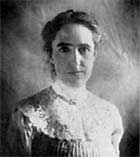
Henrietta Leavitt
During the showtime decade of the 1900s Henrietta Leavitt (1868 - 1921), working at the Harvard College Observatory, studying photographic plates of the Big (LMC) and Small (SMC) Magellanic Clouds, compiled a list of ane,777 periodic variables. Eventually she classified 47 of these in the two clouds every bit Cepheid variables and noticed that those with longer periods were brighter than the shorter-menstruum ones. She correctly inferred that as the stars were in the same distant clouds they were all at much the aforementioned relative distance from united states of america. Any deviation in apparent magnitude was therefore related to a difference in accented magnitude. When she plotted her results for the two clouds she noted that they formed distinct relationships between brightness and menstruum.
Her plot showed what is now known as the period-luminosity relationship; cepheids with longer periods are intrinsically more luminous than those with shorter periods.
The Danish astronomer, Ejnar Hertzsprung (1873-1967) quickly realised the significance of this discovery. By measuring the period of a Cepheid from its light curve, the distance to that Cepheid could be adamant. He used his data on nearby Cepheids to calculate the distance to the Cepheids in the SMC as 37,000 light years away.
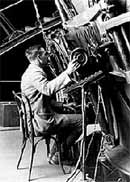
Credit: The Hale Observatories, courtesy AIP Emilio Segre Visual Archives
Edwin Hubble at the 100" Hooker Telescope on Mt Wilson
Harlow Shapley, an American astronomer using a larger number of Cepheids, recalibrated the absolute magnitude scale for Cepheids and revised the value of the distance to the SMC to 95,000 light years. He likewise studied Cepheids in 86 globular clusters and plant that the few dozen brightest non-variable stars in each cluster was about 10 × brighter than the average Cepheid. From this he could infer the distance to globular cluster too distant to accept visible Cepheids and realised that these clusters were all essentially the same size and luminosity. By mapping the distribution and distance of globular clusters he was able to deduce the size of our galaxy, the Milky Fashion.
In 1924 Edwin Hubble detected Cepheids in the Andromeda nebula, M31 and the Triangulum nebula M33. Using these he determined that their distances were 900,000 and 850,000 low-cal years respectively. He thus established conclusively that these "screw nebulae" were in fact other galaxies and non function of our Milky way. This was a momentous discovery and dramatically expanded the scale of he known Universe. Hubble subsequently went on to find the redshift of galaxies and suggest that this was due to their recession velocity, with more distant galaxies moving away at a higher speed than nearby ones. This relationship is at present called Hubble's Law and is interpreted to mean that the Universe is expanding.
Calculating Distances Using Cepheids
Both types of Cepheids and RR Lyrae stars all exhibit distinct period-luminosity relationships as shown below.
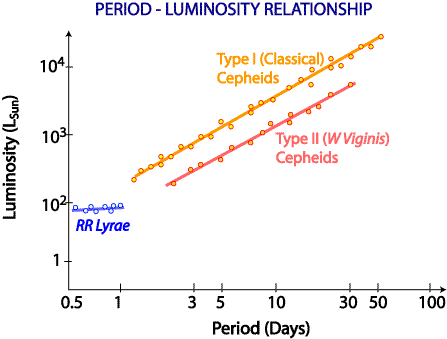
Period-luminosity relationship for Cepheids and RR Lyrae stars.
Let u.s. now see how this human relationship can be used to make up one's mind the distance to a Cepheid. For this process we will presume that nosotros are dealing with a Blazon I, Classical Cepheid but the aforementioned method applies for Due west Virginis and RR Lyrae-type stars.
- Photometric observations, be they naked-eye estimates, photographic plates, or photoelectric CCD images provide the apparent magnitude values for the Cepheid.
- Plotting apparent magnitude values from observations at different times results in a low-cal curve such as that below for a Cepheid in the LMC.
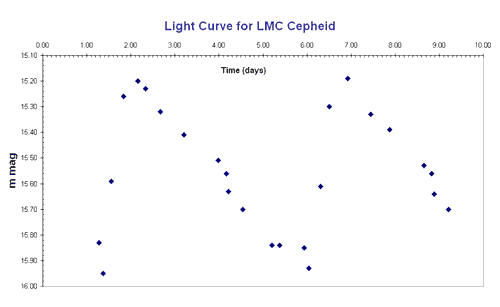
- From the calorie-free curve and the photometric data, two values can be determined; the average credible magnitude, grand, of the star and its period in days. In the example higher up the Cepheid has a mean apparent magnitude of 15.56 and a menses of 4.76 days.
- Knowing the period of the Cepheid we can now decide its mean accented magnitude, Chiliad, by interpolating on the period-luminosity plot. The one shown beneath is based on Cepheids inside the Milky way. The vertical centrality shows accented magnitude whilst menstruum is displayed as a log value on the horizontal axes.
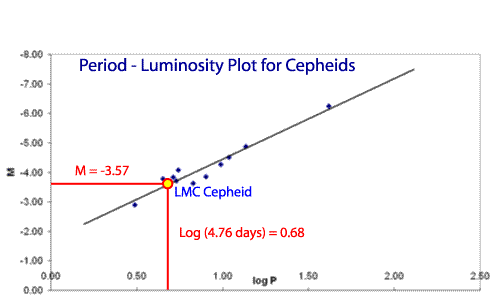
The log of 4.76 days = 0.68. When this is plotted a value of about -3.half dozen results for absolute magnitude.
- In one case both apparent magnitude, thousand, and accented magnitude, M are known we tin can but substitute in to the distance-modulus formula (four.two) and rework it to give a value for d, the distance to the Cepheid.
m - K = 5 log(d/10) (iv.2)
equally you should recall, this can be rewritten as:
d = 10 (m - G + v)/5
now substituting in:
d = 10 (15.57 - (-3.half dozen) + 5)/five
d = 10 24.17/5
d = 10 iv.834
d = 68,230 parsecs
This means that the Cepheid in the LMC is about 68.2 kpc (or about 222,000 light years away). More importantly, if nosotros infer that the size of the LMC relative to its distance from us is small we have besides found the altitude to the LMC within which the Cepheid is located.
- In practice astronomers would effort and detect as many Cepheids as possible in another galaxy in order to decide a more authentic distance. As the number of stars observed get up the uncertainties involved in calculations for individual stars can exist statistically reduced.
The basic steps, therefore for altitude calculation using pulsating variables are straightforward though the detail makes information technology harder in practise.
Standard Candles
The term standard candle applies to celestial objects with well-defined absolute magnitudes which are causeless to not vary with age or distance. Blazon I and 2 Cepheids and RR Lyraes are all examples. All Cepheids with a certain period are assumed to have the aforementioned absolute magnitude. Measuring the apparent magnitude of a Cepheid then allows united states to determine its distance using the flow-luminosity relationship. If two Cepheids have the same catamenia but is fainter than the other it must be further abroad. RR Lyraes similarly can exist used equally standard candles although as their intrinsic luminosity is lower than Classical Cepheids they cannot be detected at the cracking distances of Cepheids.
Blazon Ia supernovae may be approximated to standard candles every bit their accented magnitude reaches most -19 at maximum effulgence. Given their extreme luminosity they can be used to probe much further out into the Universe than Cepheids. Ii contempo projects, the Supernova Cosmology Projection and the High-Z SN Search have both observed dozens of supernovae in distant galaxies to effort and determine H and the geometry of the Universe. Both teams independently arrived at the the determination that not merely is our Universe expanding merely it is actually accelerating, a result that the prestigious American magazine Science announced was the inquiry advance of 1998.
The Hubble Central Project
The US$2 billion Hubble Infinite telescope was built and launched in 1990 to conduct observations non so achievable using ground-based telescopes. One of its major initial observational programs, dubbed the Hubble Fundamental Project, was aimed at refining and calibrating the extragalactic distance calibration by observing Cepheids in other galaxies. The goal was to use the recalibrated calibration to calculate a more precise value for the Hubble Constant, H0 which at that time was measured as somewhere between 50 and 100 km south-1 Mpc-1 (kilometres per 2d per megaparsec) depending on the method used.
The international squad of astronomers discovered many new cepheids in the 18 galaxies they studied. In the behemothic screw M81, for instance they found 32 Cepheids to add to only two that had been plant previously using basis-based telescopes. Using the HST they made 22 twenty-minute exposures of each of two fields in Thou 81containing the Cepheids. One time the data from these was reduced they were able to summate a distance to M 81 of 3.4 megaparsecs (about eleven million light years) compared to the previous range of values of 1.3 to v.6 megaparsecs.
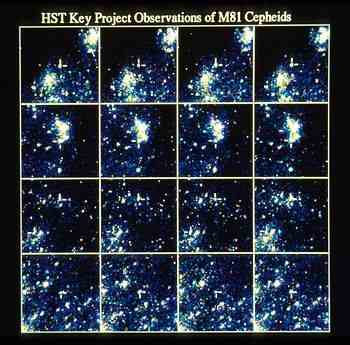
HST images of Cepheids in M 81. Each row shows four successive views of function of the field containing a Cepheid marked with dashes.
The final results of the Key project, published in 2001 gave a value of H0 = 72+/-8 km due south-ane Mpc-1. This value was based on the results of the Cepheid studies which were and so combined with other techniques such as observations of Type Ia supernovae, Blazon Two supernovae, the Tully-Fisher relation and the surface effulgence of galaxies. The incertitude of the value was shut to the original +/- 10% target for the project.
Source: https://www.atnf.csiro.au/outreach/education/senior/astrophysics/variable_cepheids.html
0 Response to "what is the distance to cepheid sy in parsecs?"
Post a Comment